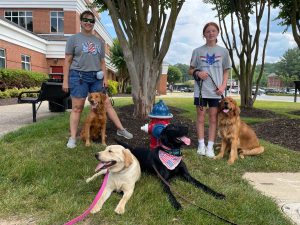Top 10 Training Tips to Make Your Dog Smile
Our service dog candidates have been training hard here at Leashes of Valor this summer! They’ve attended golf tournaments, community meet-and-greets, and fundraisers. And when the weather got hot, our trainers took them indoors: They practiced riding escalators and elevators in Richmond, rode the trolley in Culpeper, and watched the new Minions movie in Fredericksburg, among other adventures.
We may be biased, but we believe we have some of the best dog trainers around. Karen and Lisa are former search and rescue K9 search specialists for FEMA. Mike is a retired police K9 dog handler. And Anna is an animal lover who has worked with service dogs, therapy dogs, and family dogs. Together, they have a combined 96 years of dog training experience.
Whether you have a puppy, a “teenager,” or an older dog, we hope these training tips they’ve put together will help you begin your training or hone your current skills.
Slow and steady wins the race. Train in bite-sized increments—working five or 10 minutes a few times a day on a command is plenty. Any longer and your dog may become distracted or frustrated.
The trifecta of training: Praise, correction, and motivation. You have to let your dog know when they’re doing exactly what you want. Be a cheerleader! Use a high-pitched, happy voice when your dog has done well. Likewise, when your dog doesn’t follow a command or does something you don’t want them to do, you have to correct them. Finally, you can’t teach your dog to do anything if you don’t motivate them. At Leashes of Valor, we rely on praise, food, and the dog’s natural desire to work.

Keep it simple. The commands we use at LOV are usually just one word—and occasionally two words: “sit,” “down,” “stay,” “wait,” “place,” and “make friends.” It’s important to use the same words to keep from confusing your dog and to get the results you want.
Timing is everything. You’ve heard that timing is everything. This is especially true when training your dog. When a dog performs a desired behavior, you have just seconds to mark it as “good.” The same goes for an undesired behavior—you have just seconds to make a correction.
Stay positive. In its simplest terms, positive reinforcement is the act of giving the dog something they enjoy when they do what you want. At Leashes of Valor, we use praise and food to reinforce this behavior. Positively reinforcing a behavior increases the chance the dog will repeat it in the future. If you tell your dog to sit and they do, immediately give them a piece of kibble. You’ll find that your dog is more likely to sit the next time they’re told.
Correct effectively. Dogs are happiest with structure and routine. Corrections are used to teach the dog they must follow commands. When you give your dog a command, give them a second to perform. If they don’t, tell the dog “uh-uh” and give them a leash correction. Repeat the command. Praise the dog when they perform the command after the correction (no reward). Match the correction to the dog—a softer, more sensitive dog needs a lighter correction to successfully stop undesired behavior.

Be pre-emptive. Puppy-proof your house with baby gates, a crate, and/or a pen. Any time the puppy (or young dog) is not directly supervised, it should be in a safe place where it can’t get in trouble. Eliminating opportunities for accidents and destructive behavior will get you through the puppy phase and ensure that bad habits never get a chance to take hold.
Use high-value treats. You might be surprised at how much harder your dog will work for an especially delicious treat. Training treats should be soft, so you don’t have to wait for the dog to chew before continuing the lesson. Check out our Amazon list and our Chewy list to see what our professional trainers use.
Lure and mold. Luring is the act of using food in your hand to lure the dog into the position or behavior you want. Molding is the act of using your hands and body to physically mod the dog into the position or behavior you want. Here’s how we do it:
- Say the word you want the dog to associate with the command, such as “sit.”
- Lure and/or mold the dog into position
- Mark the behavior by saying “yes!”
- Immediately give the reward—a treat and praise.
Dog training is a marathon, not a sprint. Dogs learn through consistency and repetition. You must be consistent with your commands and constantly reinforce those commands. (More on commands later!) Dog training is also a lifelong process. Your dog won’t pick up everything overnight.
Retired Marine Corps Capt. Jason Haag is the founder and CEO of Leashes of Valor.
